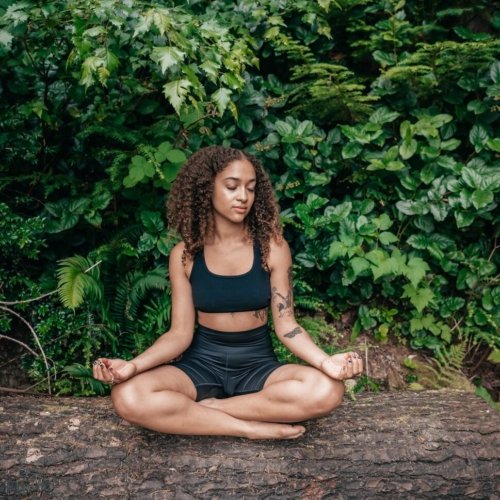Why practice 10-minute meditation?
Meditation means something different to everyone. It doesn’t have to be an enlightened state in which we totally detach from our minds. Not everyone will succeed in it, and certainly not at the beginning of our journey with meditation. The main purpose of a 10-minute meditation should be to ground yourself in your body, get to know your mental structure, strengths, and shortcomings, as well as give yourself some time off the external world to look inside. Meditation is really one of the best methods to calm down, relieve stress, uplift your mood and live in harmony with your emotions. It is for everyone who needs a pause from everyday matters and a moment of pure relaxation or healthy reflection.
The scientifically proven effects of meditation
In the 1970s, Western medicine became interested in meditative practices and their effects. Mindfulness became a tool of cognitive and behavioral therapies, under the impulse of the American physician Jon Kabat-Zinn in particular. Meditation has nothing mystical about it, especially in the way it is practiced in the West. It is rather a form of training of the mind. A muscular reinforcement of the brain, a way to gain control over your life and take responsibility for your happiness. A 10 minute meditation for anxiety can change your life as you react to nothing and start accepting everything.
Science has proven that a regular practice of a 10-minute meditation can reduce pain, stress, anxiety, eating and sleeping disorders, prevent depression, improve focus and concentration, emotional management, and creativity. Some studies even show the effects of meditation on cardiovascular health or immunity.

What Do You Need To Start Your Meditation Routine?
You don’t need absolutely anything for ten-minute meditations. Not even a yoga mat or some kind of special music. You don’t need to get into a fancy position or wear loose clothing. Those things do help, but they are by no means necessary. Meditation in everyday life can look completely different. The important thing is to adapt it to your own needs. If we need one thing, it is yourself. A peaceful environment might also help.
Meditation time should be a moment that is reserved just for us. No one should disturb or distract us. Although when we do learn to meditate, we’ll be able to do it even in a crowded bus during peak travel times. But to begin with, it’s definitely easier to meditate when we’re not distracted by anything or anybody.

Create A New Habit Of Meditating Every Day
Meditation is similar to a workout. The more we practice the skill, the greater the results we get, and the better we can use it. For this reason, it is best to meditate every day if you can. Making meditation a regular part of your day is more important than how long you meditate. It won’t do you any good to meditate for 2 hours one day if you happen to have the time, and you’ll feel guilty for the rest of the week if you can’t keep it up. Here are some tips to create a regular meditation habit:
- Choose a fixed time of day when you devote yourself to meditation. We find that it is best to do a 10 minute morning meditation right after you get up.
- If you miss a day, that’s okay too. Part of meditation involves self-compassion. Focus on days of the week or month when you did meditate, rather than one day when you didn’t.
- If you’re not reaching your daily meditation goal, try reducing the number of minutes a bit until you reach an amount you can maintain every day. This eases the pressure so you can get used to it at first and then build up to longer meditations when you are ready.
A 10 Minute Meditation Exercise
Mindfulness is otherwise known as being present, being here and now, focusing with full attention on what is given in the moment. How to achieve this state of full presence and surrender to what is? Here’s a 10 minute guided meditation to get you started.
Stop what you are doing. Begin with a conscious intention to completely relax your body and mind and receive the gift of healing. Close your eyes, take a few deep breaths, and settle into a comfortable body position. Try to let go of anything that occupies your mind by feeling everything but reacting to nothing. This is your time to relax and it is important that nothing distracts you, both externally and internally.
Focus on your breath coming in and out of your nostrils. If thoughts and emotions swirl your mind, just return to your breath. Is it long or short? Deep or shallow? How do you feel as you observe yourself?
When you’re ready you can slowly wrap up the practice, stretch and slowly stand up. Try to keep this energy flowing in the activities you’re going to resume.
Are you new to meditation? Follow the Yogilab to get daily insights and guidance, as well as motivation from an ever-growing online meditation community.
Why practice 10-minute meditation?
Meditation means something different to everyone. It doesn’t have to be an enlightened state in which we totally detach from our minds. Not everyone will succeed in it, and certainly not at the beginning of our journey with meditation. The main purpose of a 10-minute meditation should be to ground yourself in your body, get to know your mental structure, strengths, and shortcomings, as well as give yourself some time off the external world to look inside. Meditation is really one of the best methods to calm down, relieve stress, uplift your mood and live in harmony with your emotions. It is for everyone who needs a pause from everyday matters and a moment of pure relaxation or healthy reflection.
The scientifically proven effects of meditation
In the 1970s, Western medicine became interested in meditative practices and their effects. Mindfulness became a tool of cognitive and behavioral therapies, under the impulse of the American physician Jon Kabat-Zinn in particular. Meditation has nothing mystical about it, especially in the way it is practiced in the West. It is rather a form of training of the mind. A muscular reinforcement of the brain, a way to gain control over your life and take responsibility for your happiness. A 10 minute meditation for anxiety can change your life as you react to nothing and start accepting everything.
Science has proven that a regular practice of a 10-minute meditation can reduce pain, stress, anxiety, eating and sleeping disorders, prevent depression, improve focus and concentration, emotional management, and creativity. Some studies even show the effects of meditation on cardiovascular health or immunity.
What do you need to start your meditation routine?
You don’t need absolutely anything for ten-minute meditations. Not even a yoga mat or some kind of special music. You don’t need to get into a fancy position or wear loose clothing. Those things do help, but they are by no means necessary. Meditation in everyday life can look completely different. The important thing is to adapt it to your own needs. If we need one thing, it is yourself. A peaceful environment might also help.
Meditation time should be a moment that is reserved just for us. No one should disturb or distract us. Although when we do learn to meditate, we’ll be able to do it even in a crowded bus during peak travel times. But to begin with, it’s definitely easier to meditate when we’re not distracted by anything or anybody.
Create a new habit of meditating every day
Meditation is similar to a workout. The more we practice the skill, the greater the results we get, and the better we can use it. For this reason, it is best to meditate every day if you can. Making meditation a regular part of your day is more important than how long you meditate. It won’t do you any good to meditate for 2 hours one day if you happen to have the time, and you’ll feel guilty for the rest of the week if you can’t keep it up.
Here are some tips to create a regular meditation habit:
- Choose a fixed time of day when you devote yourself to meditation. We find that it is best to do a 10 minute morning meditation right after you get up.
- If you miss a day, that’s okay too. Part of meditation involves self-compassion. Focus on days of the week or month when you did meditate, rather than one day when you didn’t.
- If you’re not reaching your daily meditation goal, try reducing the number of minutes a bit until you reach an amount you can maintain every day. This eases the pressure so you can get used to it at first and then build up to longer meditations when you are ready.
A 10 minute meditation exercise
Mindfulness is otherwise known as being present, being here and now, focusing with full attention on what is given in the moment. How to achieve this state of full presence and surrender to what is? Here’s a 10 minute guided meditation to get you started. Stop what you are doing. Begin with a conscious intention to completely relax your body and mind and receive the gift of healing. Close your eyes, take a few deep breaths, and settle into a comfortable body position. Try to let go of anything that occupies your mind by feeling everything but reacting to nothing. This is your time to relax and it is important that nothing distracts you, both externally and internally.
Focus on your breath coming in and out of your nostrils. If thoughts and emotions swirl your mind, just return to your breath. Is it long or short? Deep or shallow? How do you feel as you observe yourself? When you’re ready you can slowly wrap up the practice, stretch and slowly stand up. Try to keep this energy flowing in the activities you’re going to resume.
Are you new to meditation? Follow the Yogilab to get daily insights and guidance, as well as motivation from an ever-growing online meditation community.




